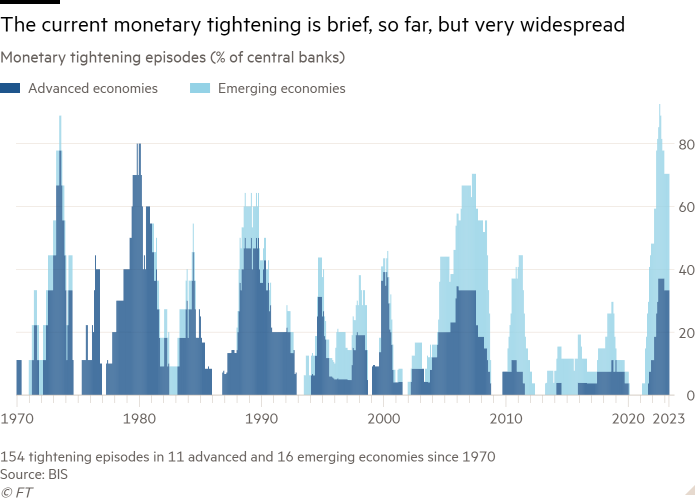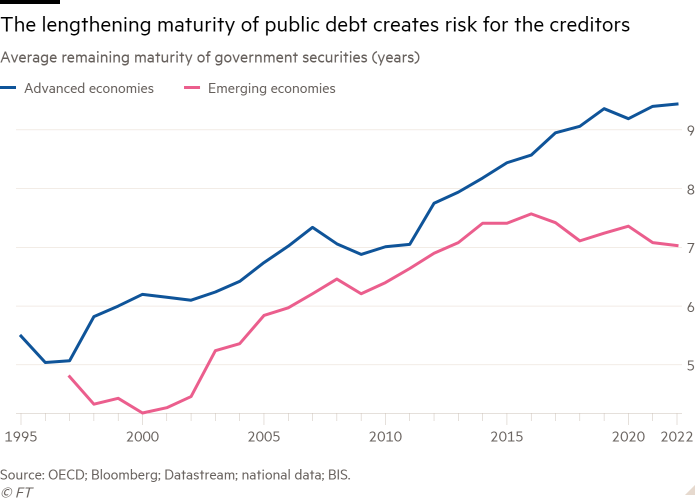Receive free Central banks updates
We’ll send you a myFT Daily Digest email rounding up the latest Central banks news every morning.
In high-income countries, consumer price inflation is running at rates not seen in four decades. With inflation no longer low, neither are interest rates. The era of “low for long” is over, at least for now. So, why did this happen? Will it be a lasting change? What should the policy response be?
Over the past two decades, the Bank for International Settlements has provided a different perspective from those of most other international organisations and leading central banks. In particular, it has stressed the dangers of ultra-easy monetary policy, high debt and financial fragility. I have agreed with some parts of this analysis and disagreed with others. But its Cassandra-like stance has always been worth considering. This time, too, its Annual Economic Report provides a valuable analysis of the macroeconomic environment.
The report summarises recent experience as “high inflation, surprising resilience in economic activity and the first signs of serious stress in the financial system”. It notes the widely held view that inflation will melt away. Against this, it points out that the proportion of items in the consumption basket with annual price rises of more than 5 per cent has reached over 60 per cent in high-income countries. It notes, too, that real wages have fallen substantially in this inflation episode. “It would be unreasonable to expect that wage earners would not try to catch up, not least since labour markets remain very tight,” it asserts. Workers could recoup some of these losses, without keeping inflation up, provided profits were squeezed. In today’s resilient economies, however, a distributional struggle seems far more likely.
Financial fragility makes the policy responses even harder to calibrate. According to the Institute of International Finance, the ratio of global gross debt to GDP was 17 per cent higher in early 2023 than just before Lehman collapsed in 2008, despite the post-Covid declines (helped by inflation). Already rising interest rates and bank runs have caused disruption. Further problems are likely, as losses build up in institutions most exposed to property, interest rate and maturity risks. Over time, too, households are likely to suffer from higher borrowing costs. Banks whose equity prices are below book value will find it hard to raise more capital. The state of non-bank financial institutions is even less transparent.

Such a combination of inflationary pressure with financial fragility did not exist in the 1970s. Partly for this reason, “the last mile” of the disinflationary journey could be the hardest, suggests the BIS. That is plausible, not just on economic grounds, but on political ones. Naturally, the BIS does not add populism to its list of worries. But it should be on it.
So, how did we get into this mess? We all know about the post-Covid supply shocks and the war in Ukraine. But, notes the BIS, “the extraordinary monetary and fiscal stimulus deployed during the pandemic, while justified at the time as an insurance policy, appears too large, too broad and too long-lasting”. I would agree on this. Meanwhile, financial fragility clearly built up over the long period of low interest rates. Where I disagree with the BIS is over whether “low for long” could have been avoided. The Bank of Japan tried in the early 1990s and the European Central Bank in 2011. Both failed.

Will what we are now experiencing prove an enduring shift in the monetary environment or just a temporary one? We just do not know. It depends on how far high inflation has been just the product of supply shocks. It depends, too, on whether societies long unused to inflation decide that bringing it back down is too painful, as happened in so many countries in the 1970s. It depends, as well, on how far the fragmentation of the world economy has permanently lowered elasticities of supply. It depends not least on whether the era of ultra-low real interest rates is over. If it is not, this could indeed be a blip. If it is, then significant stresses lie ahead, as higher real interest rates make current levels of indebtedness hard to sustain.

Finally, what is to be done? The BIS believes in the old-time religion. It argues that we have put too much trust in fiscal and monetary policies and too little in structural ones. Partly as a result, we have pushed our economies out of what it calls “the region of stability”, in which expectations (not least of inflation) are largely self-stabilising. Its distinction between how people behave in low inflation and high inflation environments is valuable. We are now at risk of moving durably from one to the other. Developments over the next few years will be decisive. This is why central banks must be rather brave.
Yet I remain unpersuaded by all tenets of this faith. The BIS argues, for example, that policymakers should have been more relaxed about persistently low inflation. But that would have significantly increased the chances that monetary policy would be impotent in a severe recession. It argues, too, that macroeconomic stabilisation is not all that important. But prolonged recessions and high inflation are at least equally intolerable. Moreover, a stable macroeconomic environment is at the least helpful to growth, since it makes planning by business so much easier.
Above all, I remain unconvinced that the dominant aim of monetary policy should be financial stability. How can one argue that economies must be kept permanently feeble in order to stop the financial sector from blowing them up? If that is the danger, then let us target it directly. We should start by eliminating the tax deductibility of interest, increasing penalties on people who run financial businesses into the ground and making resolution of failed financial institutions work.
Yet the BIS always raises big issues. This is invaluable, even if one does not agree.





Comments are closed, but trackbacks and pingbacks are open.